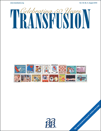The influence of conditions utilized to hold apheresis and whole blood–derived platelet samples before platelet enumeration with three hematology analyzers
Abstract
BACKGROUND: The Advia 120 (Siemens Diagnostics) hematology analyzer is different from other hematology analyzers in that it requires platelets (PLTs) to be “effectively spherical” to be counted. Our study evaluated how PLT counts with this hematology analyzer and two other models were influenced by the holding of PLT product samples.
STUDY DESIGN AND METHODS: Samples were prepared from apheresis PLT products (APs) collected in ACD-A and from whole blood–derived PLT concentrates (PCs) in CP2D or ACD-A. Samples were stored in K2 and K3ethylenediaminetetraacetate (EDTA) tubes at room temperature (RT) and in the cold. PLT counts were determined immediately, after 1 and 4 hours, and after an overnight hold, using Advia 120, XE-2100D, and Cell-Dyn 3700 hematology analyzers.
RESULTS: A time-dependent increase in PLT counts was observed with AP samples held at RT using the Advia 120, but not with the other two hematology analyzers. AP samples held in the cold did not show a substantial time-dependent increase with any of the hematology analyzers. With the Advia 120, the PLT counts in the immediate samples were approximately 14% lower compared to those in cold or overnight-held RT samples. PC samples with all holding conditions and hematology analyzers did not show any substantial time-dependent increase in counts.
CONCLUSIONS: With the Advia 120 hematology analyzer, the time-dependent increase in PLT counts with RT-held samples may be related to the need to have effectively sphered PLTs unlike that with the other two hematology analyzers. The absence of a holding effect with PC samples may indicate that only AP samples have population(s) that are slow to convert to spherical PLTs.




